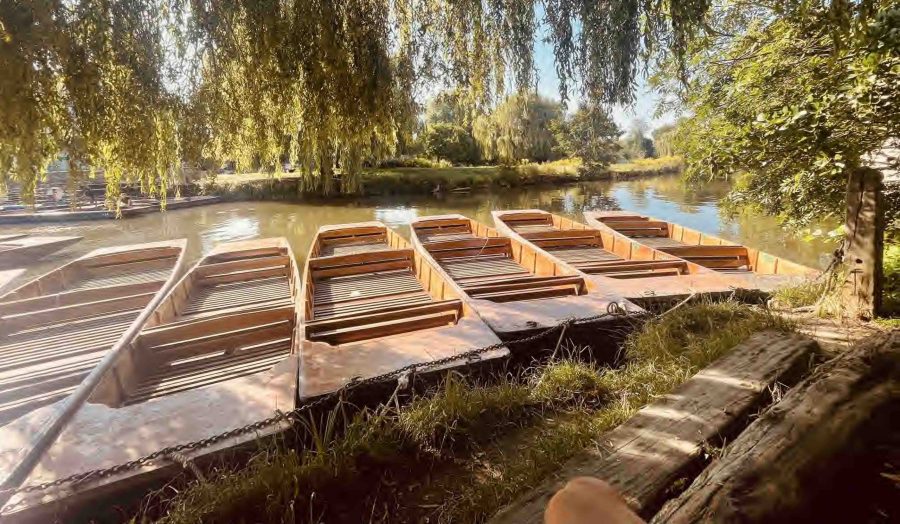There are three public bridges along The Backs, a scenic section of the river Cam which runs through the grounds of 8 University colleges. Most of the land along this stretch of the river is owned by the colleges, 5 of which have private bridges to cross between the north and south side of the river.
Although most of the college backs are private and charge an entrance fee for visitors, there are 3 public bridges which offer views into the colleges.
For those joining one of our punt tours, Magdalene Bridge is the first to be seen as you approach Quayside and marks the crossing between the commercial part of the city into the privately owned picturesque grounds of the colleges.
Magdalene bridge, pronounced Maudlyn, sits on one of the oldest settlements in Cambridge, dating back 2,000 years when the site was a Roman camp and river crossing. The surrounding area would have been surrounded by marshlands and the original Roman bridge connected the Roman settlement of Colchester in the south-east to the town of Chester in the north-west.
Strategically important for military purposes and trade, the Quayside river crossing intersects with the River Cam as it flows out to the coastal town of King’s Lynn and eventually to continental Europe. This helped Cambridge to establish itself as a major inland port and a key location for trade in East Anglia.
Although there has been a river crossing since the Romans, the first records of the bridge date back to 875, with a reference to ‘Grantabryce’ in an Old English collection of Anglo-Saxon historical documents known as The Chronicles.
The first stone bridge on the site was constructed in 1754, following centuries of wooden bridges being in a constant state of disrepair. The stone bridge was designed by James Essex, the same architect behind Trinity Bridge and The Mathematical Bridge, for a total cost of £1,600.
Designed by Benjamin Brown and Arthur Browne, the current bridge was first built in 1823 and after repaired and strengthened for vehicles in 1832. The bridge is grade II listed, constructed from cast iron and ashlar (finley dressed stone pillars). One of the first iron cast bridges to be constructed in England, the main section of the bridge was cast in Derby for a cost of £2,350 ( £175,000 adjusted for inflation).
As you continue up the river, past Magdalene, St.John’s and Trinity, evenly you will pass the Garret Hostel Bridge, the second public bridge over the backs. The foot and cycle bridge is one of the busiest (and potentially dangerous) in Cambridge during the summer months as there is a constant stream of students on bicycles weaving through large groups of tourists taking pictures of the surrounding views of Clare Bridge, Trinity Bridge and St.Johns New Court.
Garret Hostel Bridge takes its name from a 14th century hostel built on the same location, which was originally owned by Michealhouse before merging with Trinity College in 1546.
There has been a bridge at this location since 1450. The current bridge is the 6th in its place and was built in 1960, replacing the cast iron bridge which has stood there since 1837. Grade II listed, the post-tension concrete bridge is constructed with New York stone and features heavily worm bronze handrail. It was designed by an undergraduate architect student named Timothy Guy who unfortunately passed away before seeing the completed bridge.
The route along the bridge connects the mediaeval backstreets of the colleges within the historic centre to the scenic tree lined pathways along the backs.
The final public bridge is located at the top of the river, and marks the entrance to the backs from Mill Pond. Silver Street Bridge was originally known as Small Bridge until 1615 ( in relation to Magdalene bridge, which was known as Great Bridge). The first reference to a bridge at this location dates back to 1396, in reference to the Hermit who would have been responsible for the bridge’s maintenance.
Clad in portland stone, the current bridge was built in 1959, although it had been designed 30 years prior by Sir Edwin Lutyenes in 1932.
Standing on Silver Street Bridge today offers the perfect vantage point of The Mathematical Bridge and the stream of punters flowing on the river underneath.
If you would like to view any of the public or private bridges along the backs, why not consider joining one of our shared punting tours?

 The most Amazing Punt Company river tour that i had with “ Josh “ he made the journey unforgettable he was explaining everything and show us every sight with details... read more “ he is such a An enthusiastic ambitious young man who works with passion and loves his job.Thanx Josh.
The most Amazing Punt Company river tour that i had with “ Josh “ he made the journey unforgettable he was explaining everything and show us every sight with details... read more “ he is such a An enthusiastic ambitious young man who works with passion and loves his job.Thanx Josh.

